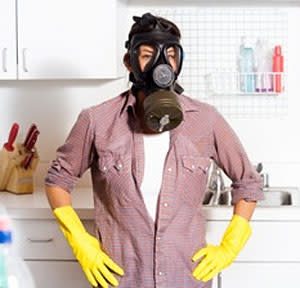Six hidden dangers in your home
By Lori Bongiorno
More from The Conscious Consumer blog

It's impossible to avoid all the potential dangers in life. But some dangers lurking in the home are easily avoided if you're armed with the right info.
Below are six accidents-waiting-to-happen and what you can do to prevent them. What do you think is missing from this list? Share other hidden, but easily preventable dangers in the comments section.
1. Mixing some cleaning products
Toxic gases can form when you use multiple cleaning products at the same time. Chloramine gas, which can be highly irritating to your lungs, forms when you mix ammonia with chlorine bleach. Mixing chlorine bleach with an acid-based product (like toilet bowl and oven cleaners, drain openers, or vinegar) can release chlorine gas, another lung-irritating fume.
Most household cleaners do not have ingredients listed on the label so it's hard to know exactly what's in a product. Chlorine bleach is often found in mildew stain removers and some bath and toilet cleaners. Glass, bathroom, and floor cleaners may contain ammonia. Try to choose cleaners that have their ingredients listed and avoid mixing cleaning products. Better yet, raid your pantry for cleaners or buy affordable nontoxic cleaners that really work.
2. Mold
Molds are fungi that can cause allergic reactions, wheezing, and other respiratory issues. They thrive in warm, damp, and humid environments.
It's difficult to find and get rid of mold so you'll want to prevent it from forming in the first place. Some ideas from The Centers for Disease Control and Prevention: Keep humidity levels in your house between 40 to 60 percent. Use an air conditioner or dehumidifier when needed. Make sure your house is well ventilated.
If you discover mold in your home, you should find and eliminate the source of moisture. You can clean mold up with commercial products, soap and water, or a mixture of 1 cup of bleach in 1 gallon of water.
3. Mixing hot oil and water
We all know that oil and water don't mix, but when it comes to hot oil, this is particularly important to remember. If water comes into contact with hot oil, it can cause the oil to splatter and may burn whoever is cooking.
So make sure you thoroughly dry any ingredients, such as washed vegetables, that you plan to add to hot cooking oil and keep water away from the pan.
4. Carbon monoxide
You can't see or smell this toxic gas so it can kill you before you even know it's in your home, according to the Environmental Protection Agency. It enters through leaking chimneys and furnaces, unvented space heaters, gas water heaters, stoves, and elsewhere. Common symptoms of carbon monoxide poisoning include headache, dizziness, nausea, vomiting, chest pain, and confusion.
You can find battery-operated carbon monoxide monitors at most home improvement stores. Consumer Reports recommends buying models that have digital displays and meet Underwriters Laboratories Standard 2034 (labeled on the packages).
Install detectors in the bedroom and other places where your family spends a lot of time and you can hear the alarm. Change the batteries regularly (such as when you change your clocks in the spring and fall for Daylight Savings), and replace monitors every five years (you can check the date on the back of the monitor).
Combination smoke and carbon monoxide detectors are also available. Smoke detectors need to be replaced every 10 years, but if you go for the combo, replace it after five years. Smoke detectors are typically installed on the ceiling, whereas carbon monoxide monitors get plugged into an outlet toward the bottom of a wall.
5. Mothballs
The strong odor mothballs emit comes from naphthalene and/or paradichlorobenzene -- toxic chemicals that are considered neurotoxins and are associated with health effects ranging from eye, nose, throat, and skin irritation to headaches, nausea, dizziness, and more. You can get exposed to these chemicals when inhaling, touching, or swallowing them (so keep away from kids and pets).
Some ideas for nontoxic moth prevention: Keep your clothing clean since the larvae, which actually do the chewing, are attracted to dirt and stains on fabric. Store sweaters in airtight containers when you're not using them for long periods of time. Wash clothes in hot water (and run through a hot dryer) or dry-clean garments to kill moths. Try putting cardboard pheromone traps in your closet to determine if you have a problem and to trap moths.
6. Boiling water in microwave
Heating water in the microwave may cause it to superheat (reach a temperature beyond the natural boiling point of 100 degrees Celsius) and potentially explode. This doesn't happen very often, but it can occur if water is heated in a very clean cup or bowl, particularly if the container is glass.
What can you do to prevent this from happening? Leave a non-metallic object in the cup or bowl when you microwave water, and be conservative about how long you heat the water up and which settings you use.
Environmental journalist Lori Bongiorno shares green-living tips and product reviews with Yahoo! Green's users. Send Lori a question or suggestion for potential use in a future column. Her book, Green Greener Greenest: A Practical Guide to Making Eco-smart Choices a Part of Your Life is available on Yahoo! Shopping and Amazon.com.
